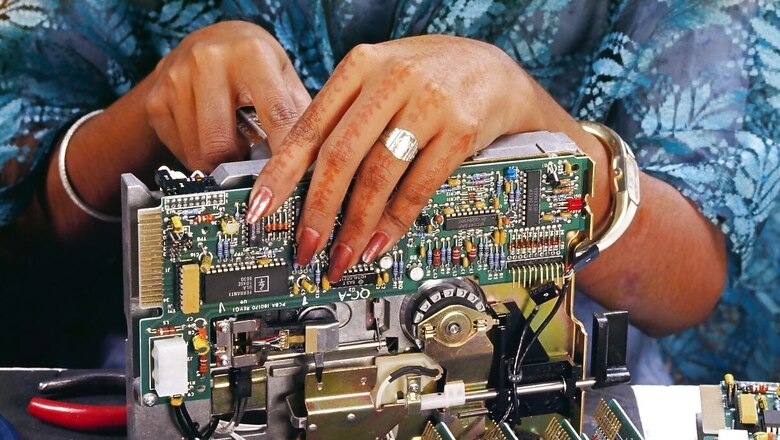
views
Amidst rapidly evolving technologies to stay globally competitive, the labour-intensive manufacturing sector has a significant opportunity to address the complex issue of unemployment in the country. The manufacturing sector has the potential to accommodate seven to eight million youths entering the labour force annually, as per the India Employment Report 2024, recently released by the International Labour Organization (ILO) and the Institute for Human Development (IHD).
The report reveals that India’s youth account for almost 83% of the unemployed workforce and the share of youngsters with secondary or higher education in the total unemployed youth has almost doubled from 35.2% in 2000 to 65.7% in 2022. The unemployment rate among youths was six times higher for those with secondary or higher education (18.4%) and nine times higher for graduates (29.1%) compared to those who cannot read and write (3.4%).
The brimming challenge of unemployment is majorly due to the skill gap towards the adoption of evolving technologies. The ILO and IHD report warned of the growing uncertainties in the labour market due to rapidly changing technologies, including artificial intelligence (AI), which will significantly impact the labour market.
AI presents a significant opportunity to enhance labour productivity and increase the incomes of workers. However, it also cautioned that disadvantaged states are less prepared for this, and active policies and programmes need to be formulated and implemented to skill youths.
A report by Nasscom-Zinnov says that India will face a shortage of 14-19 lakh tech professionals by 2026. As compared to the current tech workforce in the country, India needs 52 lakh tech professionals. By 2026, India is estimated to have 75-78 lakh tech professionals. However, the requirement is being pegged at 93-96 lakh techies, reflecting a gap of 14-19 lakh tech workforce.
The skills gap is not solely due to the digital transformation of the industry; it is creating more job opportunities in operations. To bridge this gap, companies must diversify and expand their workforce to include workers with expertise in robotics, the Internet of Things (IoT), AI, and analytics. Job openings for roles such as Robot Teaming Coordinators, Smart Factory Managers, Digital Twin Engineers, and Smart Quality Assurance (SQA) Managers are increasingly common. Companies must embrace these changes and take proactive measures to address the skills gap to stay competitive in the market.
Out of the 468 million people in the workforce, 92% are in the informal sector. Shockingly, only 31% are literate, with 13% having only primary education and 6% being college graduates. Moreover, only about 2% of the workforce has formal vocational training, and just 9% have non-formal vocational training. There is a need to increase the proportion of formally skilled labour from 5.4% to at least 15% of India’s workforce by 2022-23. However, this goal has not yet been achieved, and it is crucial to re-evaluate our strategies to address this gap.
Given these discouraging realities, addressing the challenges requires collaboration among stakeholders, including governments, educational institutions, industries, and individuals to create a skilled and efficient workforce ecosystem. It is not enough to simply have degrees; we must prioritise inclusivity and eliminate divisions based on gender, location, and organised or unorganised work. This requires a comprehensive approach.
We must bring our skill development infrastructure up to global standards by creating National Occupation Standards (NOS) and Qualification Packs (QP) that meet international requirements for various job roles. It is imperative to act with urgency and determination to achieve these goals for globally competitive smart manufacturing.
Revisit the skill gap
The labour force from agriculture predominantly shifted to the construction and services sectors, highlighting a clear mismatch between job creation and the skill sets of the workforce.
The National Skill Development Corporation (NSDC) should collaborate with industries to identify skill gaps. Establishing a District-level Skill Development Plan (DSDP) to create a state-level Skill Development Plan (SSDP) is crucial. The central and state governments must share the financial burden of unskilled workers with employers for the first six months. Addressing the gap between the demand and supply of skilled workers through on-the-job training (OJT) is essential.
Fostering a culture of continuous learning and upskilling within workforces is essential for maintaining competitiveness. Employers should provide access to training programmes and resources to enhance individual skill sets and foster adaptability and innovation within the organisation.
Public-private partnerships
Encouraging collaborations between governments, educational institutions, and industries is crucial for designing and implementing targeted training programmes that directly address skill gaps in specific sectors. This collaborative approach ensures alignment between educational curricula and industry needs, promoting effective skill development and enhancing workforce readiness for the evolving demands of various sectors.
Creating apprenticeship and mentorship programmes is integral, enabling experienced professionals to transfer their invaluable knowledge and skills to the next generation. These initiatives not only bridge the skills gap but also foster a culture of experiential learning and continuous improvement within the workforce.
Supportive government policies that offer tax incentives to companies investing in employee training play a core role in progressive workforce development. These mechanisms encourage the private sector to prioritise continuous skill building, creating a resilient and adaptable workforce.
In conclusion, it is crucial to have proactive collaboration among stakeholders, make strategic investments in education and training, foster a culture of continuous learning, and promote diversity and inclusion. These factors are all essential in addressing the evolving challenges of the labour-intensive manufacturing sector. Ignoring any of these aspects would hinder our ability to build a strong and sustainable workforce for the future.
The writer is co-founder and MD, Orane International, Training Partner with National Skill Development Corporation (NSDC), Network Member, India International Skill Centres, an initiative of GoI. Views expressed in the above piece are personal and solely those of the author. They do not necessarily reflect News18’s views.



















Comments
0 comment